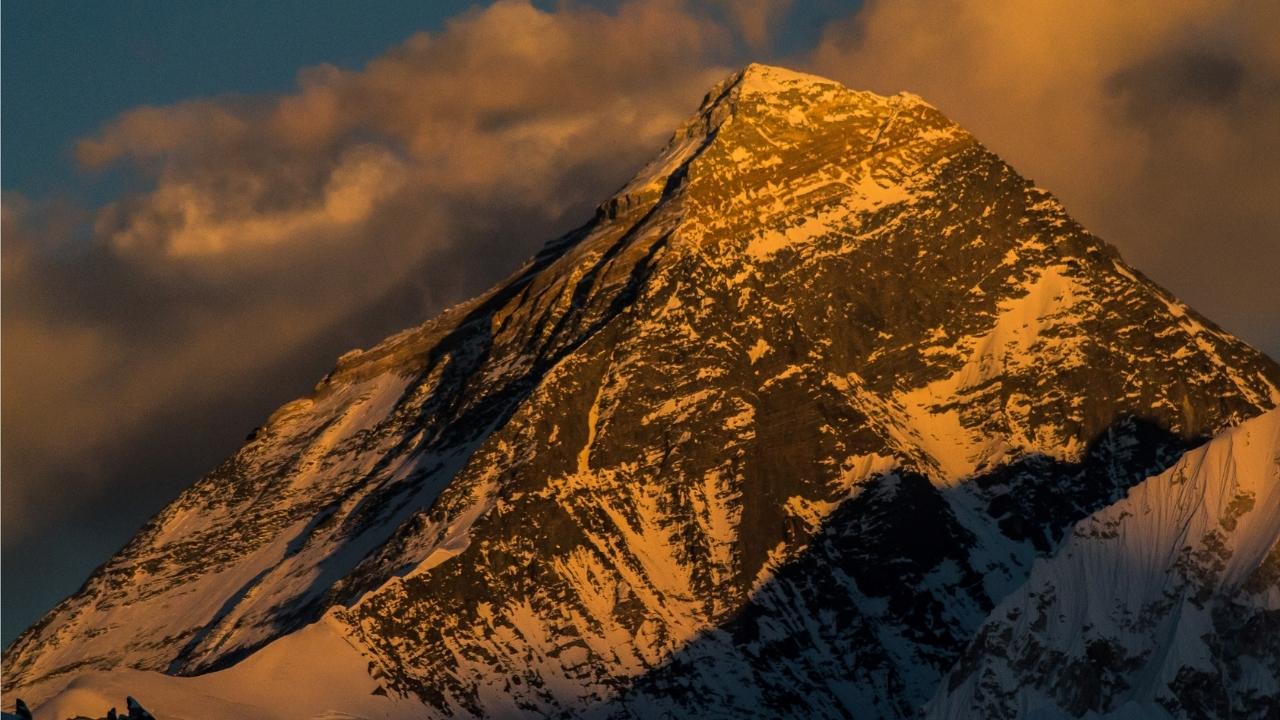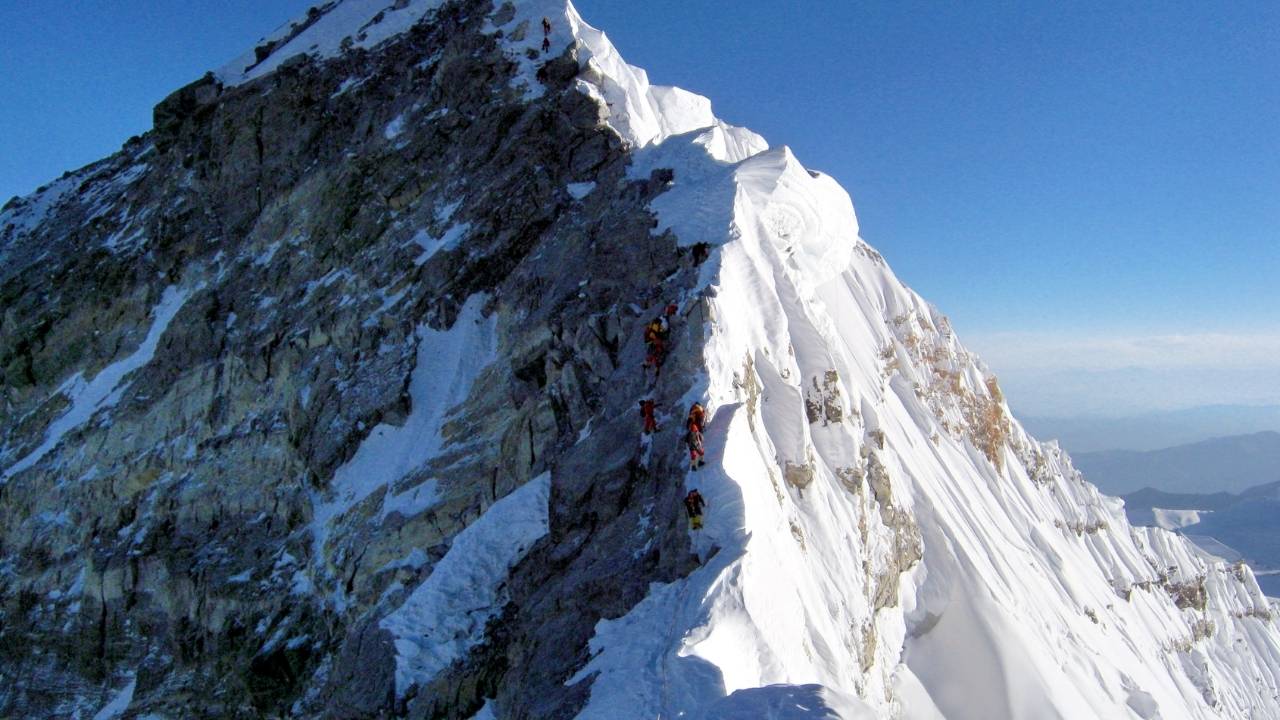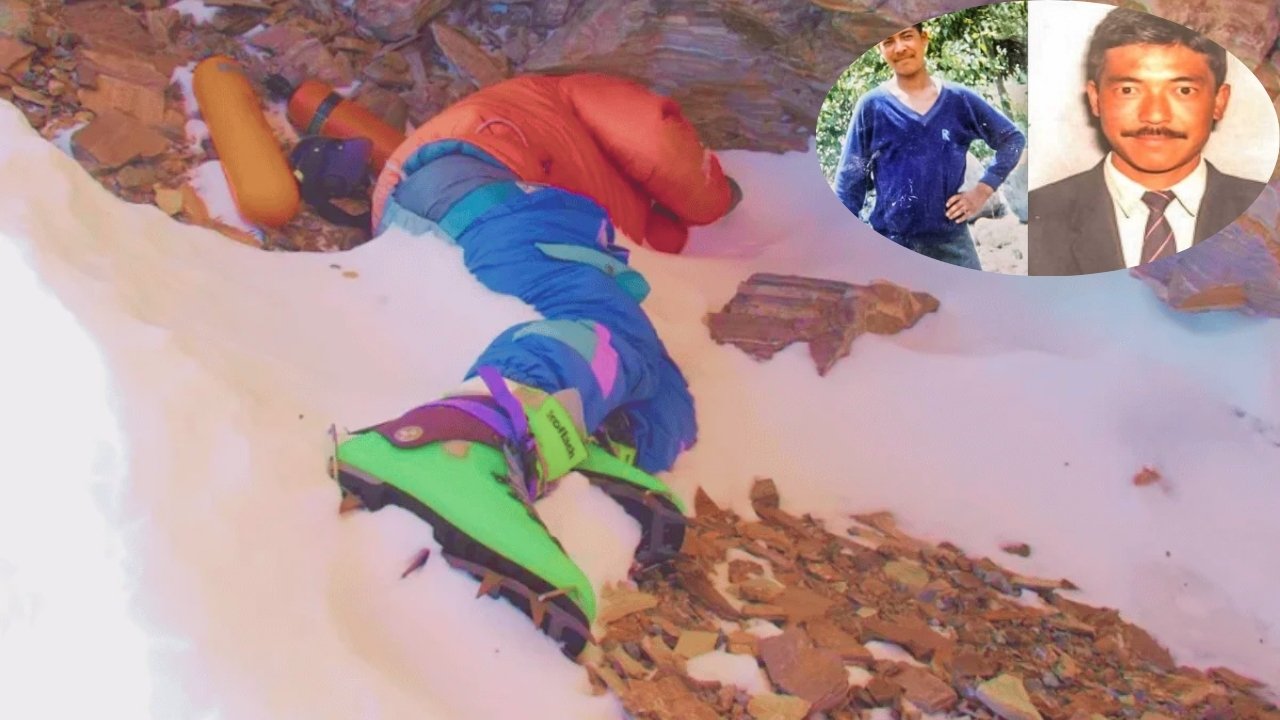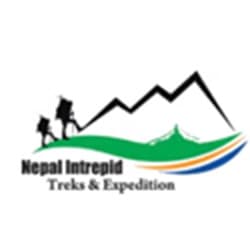Everyone has once dreamed of standing on top of the world. Climbing Everest sounds so exciting, but above 8,000 meters, the mountain does not care about your dreams. Selfies or fancy climbing boots really do not matter on the peaks that touch the sky. Welcome to the Everest Death Zone, where every step is a test of survival.
Mount Everest is known as the roof of the world. This peak stands at an altitude of 8,848.86 meters (29,031.7 ft). Each year, hundreds of climbers from all around the world attempt to reach the Everest summit. People visit here seeking adventure, glory and the thrill of standing at the highest point on the Earth. Behind the breathtaking views of mountains, there is a harsh reality behind the mountains. Especially the unforgiving nature of Everest in its final stretch on the Everest death route.

The death zone begins at high above Camp 4 to the South Col. At this altitude, the air becomes dangerously thin, where the human body needs to struggle to survive. Even simple tasks like walking, thinking and even breathing become a challenge. You have to face extreme cold, powerful winds and a lack of oxygen, which gradually shuts down the human body.
More than 330 climbers have lost their lives on Everest and many have taken their last breath in the notorious Death Zone. Some of the bodies are still on the slopes of peaks because it is almost impossible to bring them down. Each hour spent on Everest is a battle against human nature. The mountain also limits human endurance.
In this blog, you can explore what the Everest Death Zone is and why it is so deadly, stories of climbers who never returned, and how climbers prepare for one of the most dangerous places on Earth.
What is the Mount Everest Death Zone?
The Everest death zone is part of Mount Everest. The death zone begins above 8,000 meters(26,247 feet). At this altitude, the air is extremely thin, which contains only one-third of the oxygen found at sea level. Climbers need to struggle here even with supplemental oxygen. In simple terms, if you stay too long in this zone, your body will stop functioning.
In the death zone, life is so harsh. In this region temperature drops below -30 °C. Winds may exceed 140km/h, which makes conditions even colder. Your muscles become weak, energy runs out and thinking becomes a serious challenge. Likewise, your every step carries risk, where one wrong move can be fatal.
The name “Death Zone” is derived from the reality that the human body can not survive indefinitely above 8,000 meters. Despite being experienced climbers, you can face serious risks like High-altitude Pulmonary Edema (HAPE), High-Altitude Cerebral Edema (HACE), frostbite and sudden exhaustion.
Early climbers discovered the danger of the Death Zone. Over the decades, climbers have learned to respect the deadly zone. This region is known as the ultimate test of endurance, preparation and judgment. Climbers who enter this Death Zone have to face extreme conditions, where survival is never guaranteed and your every decision matters.
Location of the Death Zone on Everest
The Everest Death Zone doesn't cover the whole mountain. Death Zone starts near the top, just above Camp 4 on Nepal's side. The death zone starts from 7,950 to all the way to the summit at 8,48.86 meters. When you enter this zone, it becomes extremely challenging to survive. Along this side, there are some well-known and dangerous landmarks:
-
The Balcony (8,400m) is a small ledge where climbers take rest, but powerful winds in this region make it hazardous.
-
South Summit (8,749m) is a steep ridge where climbers get extremely tired and short of oxygen.
-
Hillary Step (8,790m) is a vertical rock that is tricky to climb and very crowded.
-
The Summit (8,848.86m) is an ultimate goal. It is also the deadliest part of the Death Zone.
The Everest Death Zone on the Tibet (North) side starts slightly lower from near Advance Base Camp (~7,900m). The North route reflects its own challenges, which include colder temperatures and a harder descent.
The death zone is the final checkpoint of Everest. In this region, climbers' strengths, oxygen supply and decision-making are pushed to the limit. Each step of yours can be very critical and one mistake can be deadly.
Why is the Death Zone so Dangerous?
The Everest Death Zone is very deadly, not because of a single problem. The region has been deadly because of different life-threatening conditions colliding at the same time. Even your very small mistake in this place can cost a life within a minute. The biggest danger is a lack of oxygen. At 8,000 meters, each breath contains only one-third of the oxygen available at sea level. Due to a lack of oxygen, your body and mind stop working.
Climbers feel dizzy, slow and confused. Simple work, like a knot or tying boots, feels like heavy work. Sometimes climbers struggle to think clearly and make poor decisions, which is known as hypoxia.

Another risk is the extreme cold of Everest. In this region, temperatures can drop below -30°C (-22°F). Strong winds make it even worse. When you don't have enough oxygen, your heart and blood circulation slow down, which increases the risk of frostbite. Your fingers, toes, nose and cheeks can freeze in minutes. In severe cases, some climbers lose their limb due to prolonged exposure.
The terrain of Everest adds even more danger for climbers. Everest's steep ice slope, narrow ridges and hidden crevasses make every step a risk. Your small slip in this place can lead to a deadly fall. Finally, the weather in the Death Zone changes suddenly. Clear skies can quickly turn into violent storms with powerful winds and snow. Rescue operations are nearly impossible at this altitude.
In summary, the Death Zone is very dangerous because this region slowly weakens your body, while it also demands your maximum strength and focus. Survival depends upon your speed, preparation and smart decisions.
Major Death Causes in the Death Zone
It is extremely dangerous to climb the Everest Death Zone. Sadly, Many climbers lose their lives in the Death Zone every year. The main causes of death are connected to height, unpleasant weather and physical tiredness.
-
Hypoxia (lack of oxygen): After climbing above 8,000 meters, the climber's body slowly stops functioning due to low oxygen. Your brain doesn't work properly, which makes decision-making very slow. Some climbers collapse because their body stops functioning.
-
HAPE (High-Altitude Pulmonary Edema): This is a serious condition when fluid fills climbers' lungs. Climbers feel like they are drowning even while breathing. Climbers cough, feel weak and have to struggle to move. Without a fast descent, HAPE is usually fatal.
-
HACE (High-Altitude Cerebral Edema): This is swelling of the brain which is caused by to lack of oxygen. HACE confuses loss of balance and sometimes hallucinations. Sometimes climbers with HACE don't even know they are dying.
-
Falls and Avalanches: The Everest Death Zone has steep, icy slopes and narrow ridges. Your single wrong step can cause a deadly fall. Ice and rock here also break loose suddenly, causing avalanches.
-
Frostbite and Hypothermia: Severe cold freezes body tissues. Climbers lose fingers, toes, or even limbs sometimes due to frostbite. This is called Hypothermia, a condition in which your body loses too much heat. This condition shuts down body organs, which can cause death.
-
Tiredness and Running Out of Oxygen: Many climbers lose their lives because they are too tired to continue moving. While others run out of oxygen cylinders and collapse before reaching safety.
Real Stories of Famous Climbers Who Never Returned
The Everest Death Zone has claimed the lives of many brave climbers. These are not just names, but they are real people with dreams, families. These are the stories that continue to haunt mountains.
Green Boots is one of the most recognized figures, an undefined climb believed to be Tsewang Paljor. He was an Indian mountaineer who lost his life in 1996 during a storm. He was found lying inside a small rock cave on the northeast route. For many years, almost every climber had to pass by his body on their way to the summit. Everest Green Boots has become a tragic landmark of Mount Everest.

Another story is of a legendary New Zealand guide, Rob Hall who also lost his life in the same 1996 Everest disasters. He chose to be with his client, Doug Hansen, who was too weak to continue. Rob sent his final message to his wife, saying, “Please don't worry too much”. He is also a reminder of Everest's brutal power.
In 2006, David Sharp, a British climber, attempted the summit alone. He collapsed near the green boots cave due to exhaustion. More than 40 climbers passed by him, but some were too weak and others were afraid to help him. These stories raise a serious question about survival vs humanity in the Death Zone.
These stories reflect that courage is not always enough on Mount Everest. The death zone demands respect from you, or it takes your life.
Why Dead Bodies Remain on Everest?
The most haunting truth about Everest is that many climbers who lost their lives in the Death Zone are never brought back home. Their bodies remain mountain. The lifeless body frozen by time, not touched by the rescue team. These bodies silently warn climbers about the danger ahead.
Safety is the main reason behind the unrecovered bodies from Everest. At an altitude of 8,000 meters, your every movement requires enormous energy. It is nearly impossible to carry a dead body weighing over 150 kg. The body can not be carried when it is frozen and packed with climbing gear. Even the strongest Sherpas have to risk their own lives while attempting to recover dead bodies from high altitude. On Everest, a rescue mission can easily turn into another tragedy.
Another problem is cost. If you want to recover a body from the Death Zone of Everest, it can cost $30,000 to $80,000 or more. Most rescue flights can not reach that altitude. Teams must climb manually to reach there. Simply, many families cannot afford it. For some, Everest is their “final resting place” like how sailors are put to rest in the sea.
Over the decades, many lifeless bodies of climbers have gathered in a sloping area near the summit. This region is also known as the Rainbow Valley. The name sounds so peaceful, but in reality, this is one of the saddest places in the world. The bright colors seen on Rainbow Valley are not the flowers, but they are frozen down suits of lifeless climbers. It is not a tourist site but a harsh reminder that Everest doesn't forgive mistakes.
Climbers' Preparation for the Death Zone
Climbing in the Everest Death Zone is not about courage. Reaching this point requires months or even years of serious preparation. Your survival in the Death Zone depends on planning, discipline and smart decision-making.
Acclimatization is the most important part of the preparation. Slowly, climbers need to adjust their bodies to high altitude. You need to spend weeks moving up and down the mountains to train your body to adjust to the Himalayas' environment. Climbers train their bodies by following a routine known as “climb high, sleep low”. These routines train your body to survive with less oxygen. Without any acclimatization, you can suffer from altitude sickness and lose your life in matter of hours at this altitude.
Physical fitness also plays a vital role. You have to train your lungs, heart and legs to handle long hours in the extreme cold and low oxygen. Only being fit is not enough alone, mental strength is also equally important. You must stay calm when tired, make smart decisions under stress and know when to turn back, even if the summit is close.
Good gear and equipment are essential for survival in the Death Zone. You can rely on windproof down suits, crampons, oxygen masks, headlamps, gloves and climbing ropes. Most of the climbers carry supplemental oxygen, which helps them breathe in the death zone.
Finally, almost every climber depends up experienced Sherpa guides. Sherpa's knowledge about mountains, weather, and rescue skills often saves lives. Preparation doesn't guarantee success, but on Everest, it is the only chance of survival in the Death Zone.
Conclusion: Respect the Mountain, Respect the Death Zone
The Everest Death Zone is more than just a dangerous part of the mountain. Death Zone is a destination that tests the true limits of human life. Above 8000 meters, the body of climbers weakens, and the mind starts to slow down. Nature will become a silent enemy of climbers. Every climber who steps into the Everest Death Zone knows they are entering a world where their survival is never promised.
Everest looks beautiful in photos, but behind its beauty, there is a pile of risk. Everest has claimed over 330 lives and many lifeless bodies are still lying on its slopes. Stories of Green Boots, Rob Hall and David Sharp always remind every climber that even experience, strength and courage sometimes are not enough. The mountain decides who returns.
Yet people still climb despite the risk, not out of recklessness but out of passion, determination and the human spirit to explore mountains. The key is to respect. Climbers need respect nature, for preparation, for safety and for life because in the Death Zone, reaching the top is optional, but coming back home is a must.
